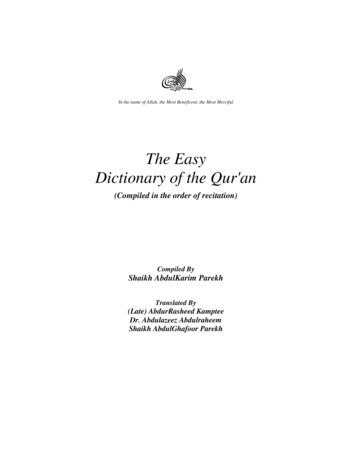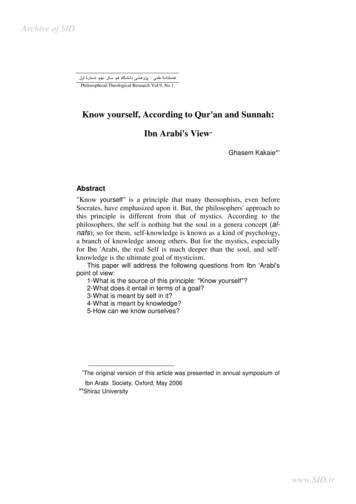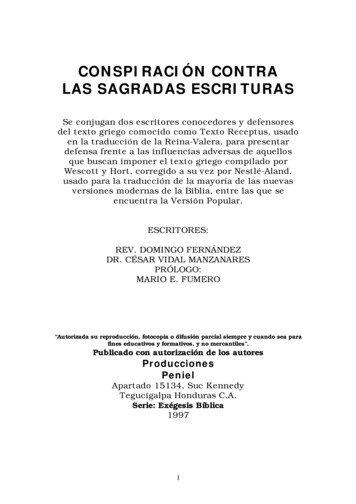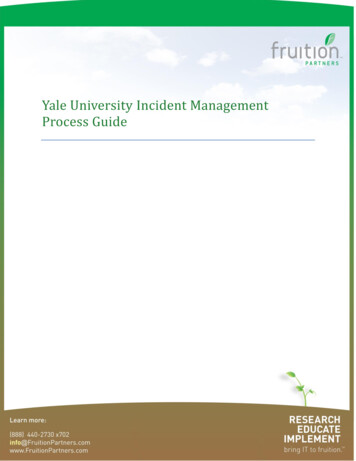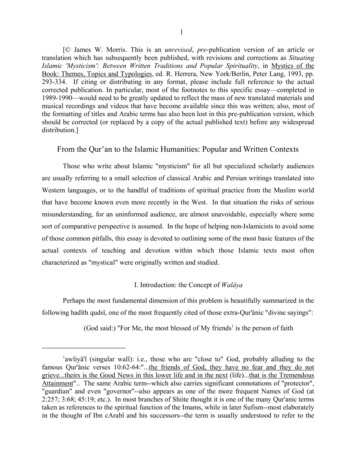
Transcription
1[ James W. Morris. This is an unrevised, pre-publication version of an article ortranslation which has subsequently been published, with revisions and corrections as SituatingIslamic 'Mysticism': Between Written Traditions and Popular Spirituality, in Mystics of theBook: Themes, Topics and Typologies, ed. R. Herrera, New York/Berlin, Peter Lang, 1993, pp.293-334. If citing or distributing in any format, please include full reference to the actualcorrected publication. In particular, most of the footnotes to this specific essay—completed in1989-1990—would need to be greatly updated to reflect the mass of new translated materials andmusical recordings and videos that have become available since this was written; also, most ofthe formatting of titles and Arabic terms has also been lost in this pre-publication version, whichshould be corrected (or replaced by a copy of the actual published text) before any widespreaddistribution.]From the Qur’an to the Islamic Humanities: Popular and Written ContextsThose who write about Islamic "mysticism" for all but specialized scholarly audiencesare usually referring to a small selection of classical Arabic and Persian writings translated intoWestern languages, or to the handful of traditions of spiritual practice from the Muslim worldthat have become known even more recently in the West. In that situation the risks of seriousmisunderstanding, for an uninformed audience, are almost unavoidable, especially where somesort of comparative perspective is assumed. In the hope of helping non-Islamicists to avoid someof those common pitfalls, this essay is devoted to outlining some of the most basic features of theactual contexts of teaching and devotion within which those Islamic texts most oftencharacterized as "mystical" were originally written and studied.I. Introduction: the Concept of WalâyaPerhaps the most fundamental dimension of this problem is beautifully summarized in thefollowing hadîth qudsî, one of the most frequently cited of those extra-Qur'ânic "divine sayings":(God said:) "For Me, the most blessed of My friends1 is the person of faith1awliyâ'î (singular walî): i.e., those who are "close to" God, probably alluding to thefamous Qur'ânic verses 10:62-64:".the friends of God, they have no fear and they do notgrieve.theirs is the Good News in this lower life and in the next (life).that is the TremendousAttainment". The same Arabic term--which also carries significant connotations of "protector","guardian" and even "governor"--also appears as one of the more frequent Names of God (at2:257; 3:68; 45:19; etc.). In most branches of Shiite thought it is one of the many Qur'anic termstaken as references to the spiritual function of the Imams, while in later Sufism--most elaboratelyin the thought of Ibn cArabî and his successors--the term is usually understood to refer to the
2who is unburdened (by possessions), who takes pleasure in prayer, who carriesout well his devotion to his Lord and eagerly serves Him in secret.He isconcealed among the people; no one points him out. His sustenance is barelysufficient, and he is content with that. His death comes quickly, there are fewmourners, and his estate is small."2Now the living presence of the "Friend of God" or walî (pl. awliyâ'), in one manifestationor another--whether it be Muhammad and his Family or certain Companions, any of the earlierprophets, the Shiite Imams, or the many pious Muslims who have come to be recognizedposthumously as "saints"--has for centuries been a central focus of popular religious anddevotional life in much of the Islamic world.3 But the true walî, as this hadîth stresses, is mostoften publicly "invisible" in this life, outwardly indistinguishable from many other normallyparticular spiritual state of proximity to God (walâya) shared by the divine Messengers, prophets(anbiyâ') and saints, besides the different spiritual functions that distinguish each of thosemembers of the spiritual hierarchy. See the more complete discussion in M. Chodkiewicz, LeSceau des saints: Prophétie et sainteté dans la doctrine d'Ibn Arabî, especially chapt. 1.In the influential poetic classics of the later Islamic humanities, this complex of Arabicterms is conveyed above all by the recurrent, intentionally ambiguous references to the"Beloved" or "Friend" (Persian Yâr or Dûst, and their equivalents in Turkish, Urdu, Malay, etc.).There this relationship of walâya/wilâya becomes the central metaphor for the divine-humanrelationship and the theophanic nature of all nature and experience.The intimately related theme of the spiritual virtues of poverty and humility stressed inthis same divine saying is likewise reflected in many other hadîth, which together help explainthe frequency of terms like faqîr and darvîsh (Arabic and Persian for "poor person", "beggar",etc.) to refer to the saints and their followers in later Islamic mysticism.2This hadîth is included, with minor variations, in the canonical collections of Tirmidhî,Ibn Mâja, and Ibn Hanbal. See the full text and notes in W.A. Graham, Divine Word andProphetic Word in Early Islam (The Hague, 1977), pp. 120-121.3Throughout this paper it should be kept in mind that the English word "saint" (and itsequivalents in other Christian contexts) is quite inadequate to convey either the centrality or thefluidity of the implicit associations and spiritual connections which are typically perceived inIslamic devotional contexts--e.g., in prayers at a specific shrine, or within a given Sufi path-between the divine al-Walî (Yâr, Dûst, etc.) and the wide spectrum of human and spiritualexemplars or "theophanies" (mazâhir) who are typically available to each individual Muslim orlocal community. And even within Islamic religious scholarship, the learned theologicalexplanations of these central popular devotional practices (e.g., in terms of functions like wasîla,shifâca, wilâya, spiritual "hierarchies," and the like) usually depend on drawing firm distinctions
3devout Muslim men and women. And even after death, for those awliyâ' whose mission ofsanctity or "proximity" to God (walâya) has become more widely recognized, the mysteriousreality of their ongoing influence likewise remains invisible to most people, revealing itselfdirectly only at the appropriate moments in individual, highly personalized means of contact:through dreams, visions, intuitions and spiritual acts of Grace (karamât) or special blessings thatonly appear to "those with the eyes to see."Thus this famous hadîth suggests two basic considerations that should be kept in mindwhenever one encounters the written works usually associated with Islamic "mysticism". Thefirst point is that with rare exceptions such texts were not originally meant to be studied bythemselves. Usually they were understood, by their author and audience alike, to be onlysecondary or accessory means to their aim (and often their source): the awliyâ'--taken in thebroadest sense, including the prophets and Imams--and the gradual realization of that spiritualcondition of walâya, or "closeness to God", embodied in such individuals.4 The second, closelyrelated point is that such "mystical" writings in their original context--and especially those workswritten in languages other than classical Arabic--were often quite inseparable from the wholerange of "popular" religion, from the faith so diversely lived and practiced by the mass of theMuslim population (in contrast to the versions represented by the Arabic traditional religioussciences and the claims of their learned urban male interpreters). In fact in many regions of theand conceptual boundaries that scarcely reflect the intimate spiritual realities of actual prayer anddevotional life.4While the different actual roles of various types of mystical writings and their interplaywith oral traditions and teaching in pre-modern contexts are discussed in more detail below, weshould add that many of the same points are also relevant to the transmission of many other(non-"mystical") forms of Islamic tradition and learning, including especially the oraltransmission of hadîth, which continued for centuries beyond the more limited domain of theirusage within the narrower sphere of Islamic law (fiqh).Perhaps the most visible and significantillustration of this point--and one by no means unique to the Islamic context-- is the fact thatmany of the "founders" and eponyms of major Sufi tariqas were either relatively anonymous (atleast in terms of contemporary written historical documentation), nearly illiterate, or authors ofrelatively few "mystical" texts if we compare them with the often prolific writers among latermembers of those same orders. The same relative anonymity often holds true as well for thoseinnumerable local saints (and in Shiite settings, relatives of the Imams) whose shrines are theobjects of pilgrimage and popular devotions throughout the Islamic world: the manifestations oftheir walâya are not sought in writing, and the "proofs" of their presence are not handed down inbooks.
4Muslim world that faith was originally spread and inculcated almost entirely by such popular"mystical" writings and their even more widespread oral equivalents, or rather above all by thesaints and other religious teachers who conveyed (and often created) both that literature and themusic and other forms of spiritual practice that typically accompanied it.If one keeps both those essential points in mind, it is easy to understand the practical andhistorical reasons behind the profusion of personalities and spiritual methods, symbols, practices,and beliefs that one discovers already in the lives of the classical exemplars of Islamic mysticismin Baghdad and Khorasan in the 3rd century (A.H.). But those same considerations also help usto appreciate the deep sense of disillusionment and failure, of something gone profoundly wrong,whenever the spiritual dimension of Islam has come to be identified with any particular,exclusive set of such historical forms.5That recurrent realization was summed up in thefrequently echoed response of the Khurasani mystic al-Qûshanjî (d. 348/959) to a disciple's naivequestion "What is Sufism (tasawwuf)?":"(Today it's) a name without reality; but it used to be a reality without a name."6Whether name or reality, the unavoidable problem for students of religion is that there isstill so little accessible literature that one can rely on to provide either of these essential contextsfor understanding the wider religious functions and meaning of the many written--and the farmore extensive unwritten--forms and expressions of Islamic mysticism.5A typical sign of this phenomenon recurring in different contexts throughout Islamichistory is the characteristic progressive socio-linguistic devaluation of technical terms once usedto refer to "mystics" as soon as the practices or institutions connected with those forms ofspirituality have become popularly routinized and "corrupted" (from the perspective of differentelites). To take only a few illustrations from the Persianate cultural sphere at very differentperiods, there is the early succession from câbid to zâhid to cârif; the eventually even morewidespread pejorative connotations of words like darvîsh, faqîr and sûfî (often coexisting withother positive meanings); and the post-Safavid Shiite scholarly opposition of terms like tasawwuf(or mutasawwifa)--in either case associated with Sunni or "folk", rural religious movements--tocirfân (true "gnosis).6The dictum is repeated in two of the most famous Persian works on Sufism, Hujwîrî's (d.ca. 465/1071) Kashf al-Mahjûb (tr. R.A. Nicholson, London, 1911, p. 44, where the name isgiven as Fûshanjî), and Jâmî's (d. 1492) biographical dictionary, Nafahât al-'Uns (ed. M.Tawhîdîpûr, Tehran, 1336 h.s./1957, pp. 255-56), apparently based on a more direct account inthe earlier Arabic Tabaqât of Sulamî (d. 412/1021).
5II. The Qur'an and the Islamic HumanitiesInterestingly enough, there is a fairly simple experiment that quickly reveals both theorigins of the many genres of Islamic "mystical" literature and the key to the contexts withinwhich they originally functioned. If one simply makes a serious effort to communicate inEnglish (or in any other non-Islamic language) something of the inner meanings and deepermessage of the Arabic Qur'ân7 to a cross-section of a given community--from children to adults,both women and men, with all their practical occupations, personal concerns, educationalbackgrounds, and spiritual and intellectual aptitudes--one quickly finds oneself obliged torecreate, in today's idiom, virtually the full spectrum of what is usually called Islamic "mystical"literature, both theoretical and practical. Hence the typologies of form and audience outlined inthe following sections are clearly determined by the necessary interplay between (a) particulartopics or teachings drawn (directly or indirectly) from the Qur'ân; (b) the attitudes, expectationsand capabilities of each particular audience; and (c) the individual teacher's own perceptivenessand creative ability--using words, music, drama, and all the other instruments of humancommunication--to evoke in each member of their audience the indispensable immediateawareness of those ever-renewed theophanies "in the world and in their souls"8 which willactually bring that spiritual message alive.7To date, even the best English "translations" of the Qur'ân bear roughly the same relationto the recited Arabic original as program notes to the actual performance of a classicalsymphony. The inadequacies of those efforts--which reflect the difficulties of the challenge,more than the talents of the translators--only highlight the extraordinary creativity and originality(and the frequently Qur'ânic inspiration) of the great masters of the poetic and musical traditionsof the Islamic humanities discussed below.Similarly, anyone performing this experiment in a Western language relatively u
Prophetic Word in Early Islam (The Hague, 1977), pp. 120-121. 3Throughout this paper it should be kept in mind that the English word "saint" (and its equivalents in other Christian contexts) is quite inadequate to convey either the centrality or the fluidity of the implicit associations and spiritual connections which are typically perceived in
